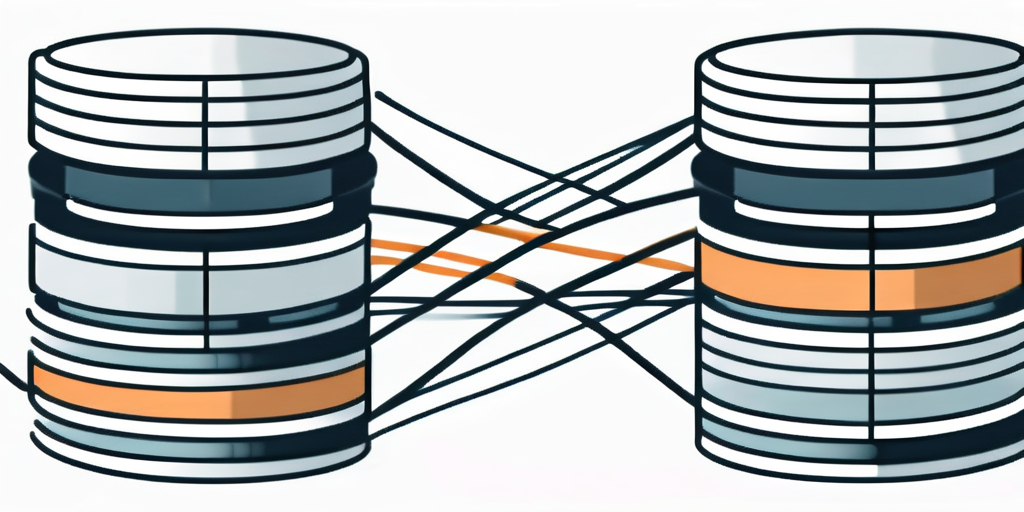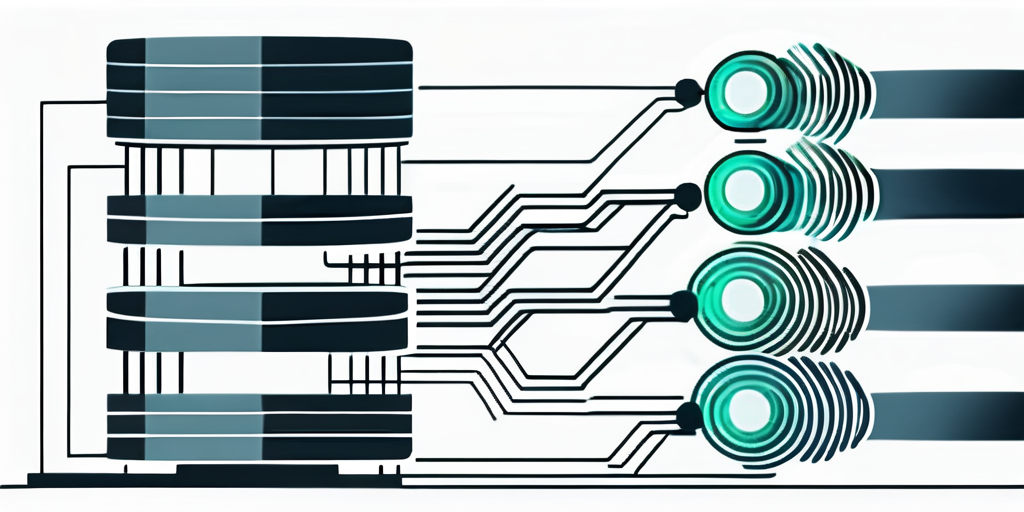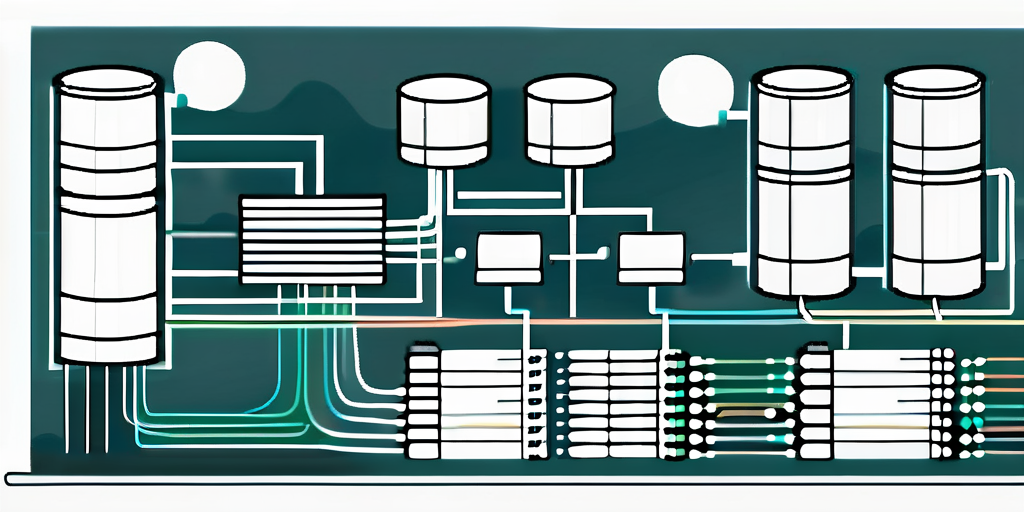
In the world of computer science, a fundamental concept that forms the backbone of data management is known as a Database Management System (DBMS). Understanding how this technology works and its various components is crucial for anyone involved in modern computing. In this article, we will delve into the basics of DBMS, explore its significance in the contemporary computing landscape, dissect its components, discuss different types of DBMS, and analyze the advantages and disadvantages it offers. Additionally, we will compare DBMS with the traditional file system to understand why DBMS has become the preferred choice for data management.
Understanding the Basics of DBMS
Before diving into the intricacies of DBMS, it is important to establish a clear understanding of its definition and functions. DBMS can be defined as a software system that facilitates the organization, storage, management, and retrieval of data. Its primary function is to provide an interface between the user and the database, enabling efficient handling of data for various applications and ensuring data integrity.

The importance of DBMS in modern computing cannot be overstated. As technology advances and reliance on data grows exponentially, the need for an efficient and reliable system to handle and process vast amounts of information becomes crucial. DBMS fulfills this need by offering a structured approach to data management, enhancing productivity, and providing a foundation for businesses to make informed decisions.
Business Utility
DBMS plays a vital role in the day-to-day operations of businesses across various industries. For instance, in the healthcare sector, DBMS is used to store and manage patient records, ensuring that medical professionals have quick and secure access to critical information. In the financial industry, DBMS is utilized to handle transactions, securely store customer data, and generate reports for regulatory compliance.
One of the key features of DBMS is its ability to provide data consistency. In a multi-user environment, where multiple users may access and modify the same data simultaneously, DBMS ensures that the data remains consistent and accurate. It achieves this through the use of transaction management, which allows for atomicity, consistency, isolation, and durability (ACID) properties.
Another important aspect of DBMS is its data security measures. With the increasing number of cyber threats, protecting sensitive data has become a top priority for organizations. DBMS incorporates various security mechanisms, such as access control, encryption, and authentication, to safeguard data from unauthorized access and ensure its confidentiality, integrity, and availability.
Scalability
DBMS also offers scalability, allowing businesses to handle growing amounts of data without compromising performance. As data volumes increase, DBMS can be scaled up by adding more hardware resources or scaled out by distributing the data across multiple servers. This ensures that the system can handle the increasing workload and maintain optimal performance levels.
In addition to these features, DBMS provides a range of tools and techniques for data manipulation and analysis. These include query languages, such as SQL (Structured Query Language), which allow users to retrieve and manipulate data in a structured manner. DBMS also supports various data models, such as relational, hierarchical, and object-oriented, providing flexibility in representing and organizing data according to specific requirements.
Overall, DBMS is a fundamental component of modern computing systems, enabling efficient and effective management of data. Its importance extends beyond just storing and retrieving information, as it plays a crucial role in supporting decision-making processes, ensuring data security, and facilitating business growth. As technology continues to evolve, DBMS will continue to adapt and innovate, providing increasingly advanced features to meet the ever-growing demands of data-driven organizations.
Components of a DBMS
When it comes to managing data, a Database Management System (DBMS) is a powerful tool that comprises several key components. These components work together harmoniously to create a seamless data management experience, ensuring efficient storage, retrieval, and manipulation of data.

At the heart of a DBMS lies the database engine. This core component is responsible for processing queries and managing the storage and retrieval of data. Think of it as the brain of the system, constantly working behind the scenes to ensure that data is organized and accessible. The database engine interacts directly with the data dictionary, which acts as a repository for metadata.
The data dictionary plays a crucial role in a DBMS. It serves as a comprehensive catalog, describing the structure and organization of the database. It contains essential information about the tables, columns, relationships, and constraints within the database. This metadata is vital for understanding the database’s schema and ensuring data integrity.
Query Processing
Another essential component of a DBMS is the query processor. This component takes user queries and translates them into executable commands. It acts as a bridge between the user and the database engine, ensuring that the desired information is retrieved efficiently. The query processor optimizes queries, making use of indexing, caching, and other techniques to enhance performance and speed up data retrieval.
But that’s not all! A DBMS also includes other components that contribute to its functionality. For example, the transaction manager ensures that database operations are executed reliably and consistently, even in the presence of failures or concurrent access. It provides mechanisms for maintaining the ACID (Atomicity, Consistency, Isolation, Durability) properties of transactions, ensuring data integrity.
Additionally, a DBMS may include a security component to protect sensitive data from unauthorized access. This component implements access control mechanisms, authentication protocols, and encryption techniques to safeguard the confidentiality and integrity of the data stored in the database.
Conclusion
Furthermore, a DBMS often incorporates a backup and recovery component. This component enables administrators to create backups of the database, ensuring that data can be restored in the event of a failure or disaster. It provides mechanisms for incremental backups, point-in-time recovery, and other strategies to minimize data loss and downtime.
Lastly, a DBMS may offer tools and utilities to facilitate database administration tasks. These tools provide functionalities such as database monitoring, performance tuning, and schema management. They empower administrators to optimize the database’s performance, troubleshoot issues, and ensure the smooth operation of the system.
In conclusion, a DBMS is a complex system composed of various components that work together to manage data efficiently. From the database engine and data dictionary to the query processor and transaction manager, each component plays a vital role in ensuring the smooth operation of the system. With the right combination of components, a DBMS provides a robust and reliable platform for storing, retrieving, and manipulating data.
Types of DBMS

When it comes to managing data efficiently, different types of Database Management Systems (DBMS) come into play. These systems are categorized based on their structure and functionality, each offering unique advantages and capabilities.

Hierarchical
One type of DBMS is the hierarchical DBMS, which follows a top-down approach in organizing data. In this system, data is structured in a tree-like format, with parent-child relationships. This means that each record in the database can have only one parent but can have multiple children. Hierarchical DBMS is particularly useful for representing data that has a clear hierarchical structure, such as an organization chart or a file system.
For example, imagine a company with multiple departments. The hierarchical DBMS can represent this structure by organizing the data in a tree-like manner, with the CEO at the top as the root, followed by the different departments as branches, and the employees as leaves. This hierarchical structure allows for efficient navigation and retrieval of data.
Network
Another type of DBMS is the network DBMS, which takes a more flexible approach to data organization. In this system, data is linked in various ways, forming a complex network. Unlike hierarchical DBMS, network DBMS allows records to have multiple parents, enabling more complex relationships between data elements.
For instance, consider a university database where students can enroll in multiple courses, and each course can have multiple instructors. The network DBMS can represent this relationship by creating links between the student records and the course records, as well as between the course records and the instructor records. This interconnected structure allows for efficient retrieval of information and supports more complex data relationships.
Relational
However, the most widely used type of DBMS is the relational DBMS. This system stores data in tables consisting of rows and columns, adhering to the relational model’s mathematical principles. Each table represents an entity, and the relationships between entities are established through keys.
For example, in a customer and order management system, there can be separate tables for customers and orders. The customer table would contain information such as customer ID, name, and contact details, while the order table would include details like order ID, date, and products ordered. The relationship between customers and orders can be established by using a common key, such as the customer ID.
The relational DBMS allows for efficient querying and manipulation of data through the use of structured query language (SQL). It provides a standardized way to manage and retrieve data, making it a popular choice for various applications, from small-scale projects to large enterprise systems.
In conclusion, DBMS comes in different types, each with its own strengths and suitability for specific data management needs. Whether it’s the hierarchical DBMS for organizing data in a top-down manner, the network DBMS for creating complex relationships, or the widely adopted relational DBMS for structured and efficient data storage, these systems play a crucial role in managing and manipulating data effectively.
Advantages and Disadvantages
One of the significant advantages of DBMS is its ability to enhance efficiency and accuracy in data management. By providing a centralized and structured approach to data storage and retrieval, DBMS eliminates data redundancy and inconsistency, ensuring data integrity and reducing the chances of human error.
Furthermore, DBMS offers improved data sharing and accessibility. With a well-designed DBMS, multiple users can access and manipulate data simultaneously, enabling collaboration and facilitating real-time decision-making. This feature is particularly beneficial in organizations where different departments or teams need to work with the same data.
Moreover, DBMS provides data independence, separating the logical and physical aspects of data storage. This means that changes in the physical storage structure, such as adding or removing storage devices, do not affect the logical organization of the data. This flexibility allows for easier system maintenance and upgrades without disrupting the applications that rely on the database.
Drawbacks
However, as with any technological solution, DBMS is not without its drawbacks. One notable concern is the issue of data security. As data becomes more valuable and susceptible to theft or unauthorized access, DBMS must implement robust security measures to protect sensitive information. Encryption, access controls, and regular security audits are essential to safeguarding the confidentiality, integrity, and availability of data stored in the database.
Additionally, managing and maintaining a complex DBMS can be challenging, requiring skilled professionals and adequate resources. Database administrators need to ensure optimal performance, monitor system health, and troubleshoot any issues that arise. This involves tasks such as database tuning, backup and recovery planning, and capacity planning to ensure the system can handle increasing data volumes and user demands.
Furthermore, as the size of the database grows, the performance of the DBMS can be affected. Queries and transactions may take longer to execute, leading to decreased system responsiveness. To mitigate this, database administrators need to implement proper indexing, query optimization techniques, and periodically review the database design to ensure efficient data retrieval and processing.
In conclusion, DBMS offers numerous advantages in terms of data management, efficiency, and accessibility. However, it also presents challenges related to data security and system maintenance. By understanding these advantages and disadvantages, organizations can make informed decisions when implementing and utilizing DBMS to meet their specific needs and requirements.
DBMS vs Traditional File System
Comparing DBMS with a traditional file system highlights the advantages and benefits DBMS offers over its predecessor. While a file system is suitable for small-scale data management, it lacks the sophisticated features and capabilities that DBMS provides. DBMS offers improved data organization, integrity checks, efficient querying, and scalability, making it an ideal choice for handling large volumes of data in modern computing environments.
One of the key advantages of DBMS over a traditional file system is its ability to provide enhanced data organization. In a file system, data is typically stored in separate files with no inherent relationship between them. This lack of structure can make it challenging to retrieve and manipulate data efficiently. In contrast, DBMS organizes data in a structured manner using tables, which allows for easier navigation and retrieval of information. Additionally, DBMS supports the use of relationships between tables, enabling complex queries and efficient data retrieval.
Another significant advantage of DBMS is its ability to perform integrity checks on data. In a traditional file system, there is no built-in mechanism to ensure data consistency and accuracy. This means that errors or inconsistencies in the data can easily go unnoticed, leading to potential issues down the line. DBMS, on the other hand, provides mechanisms such as constraints and triggers to enforce data integrity rules. These rules can prevent invalid data from being entered into the system and ensure that the data remains consistent and reliable.
Benefits
Efficient querying is also a notable benefit of DBMS. In a file system, retrieving specific data can be a time-consuming process, especially when dealing with large amounts of information. DBMS, however, offers powerful query languages such as SQL (Structured Query Language), which allows users to retrieve data based on specific criteria quickly. This ability to perform complex queries efficiently is particularly valuable. Especially in scenarios where data needs to be analyzed or filtered based on various conditions.
Scalability is another area where DBMS excels. In a traditional file system, as the volume of data grows, managing and accessing that data becomes increasingly difficult. DBMS, on the other hand, is designed to handle large volumes of data effectively. It can scale horizontally by distributing data across multiple servers or vertically by adding more resources to a single server. This scalability ensures that it can accommodate growing data needs without sacrificing performance or data integrity.
So why choose DBMS over a traditional file system? The answer lies in the enhanced functionality, scalability, and reliability that DBMS offers. By providing a structured and secure approach to data management. It streamlines operations and enables businesses to harness the power of their data effectively.
In conclusion, DBMS plays a vital role in modern computing. Its role in data organization, storage, management, and retrieval cannot be underestimated. By understanding the basics and components of DBMS, exploring its various types, and evaluating its advantages and disadvantages, we can comprehend why it has become the go-to choice for efficient and secure data management. The comparison between DBMS and the traditional file system further solidifies the superiority of DBMS in handling complex data requirements. As technology continues to evolve, it will undoubtedly remain a cornerstone of modern computing, revolutionizing data management practices.